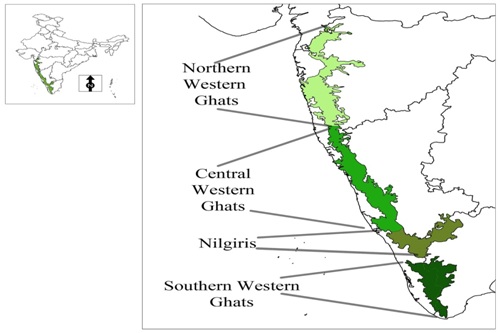

Context
There is a lack of consensus on implementation of recommendations made by Kasturirangan Committee for preservation Western Ghats. While it is important to preserve fragile Western Ghats, a collective action is need of the hour.
Recently, a virtual meeting was held by central government on the implementation of the Kasturirangan report which Karnataka government has stated its opposition on implementation of the report due to its effect on the livelihood of people in the region.
Background
- In view of significance of Western Ghats from ecological perspective, an expert panel (Gadgil commission) was set up by the Ministry of Environment and Forests of India in 2010 to find a strategy for conserving these Ghats.
- Recommendations of Gadgil committee report-
- The reportclassified the extensive region of 64% of the Western Ghats into Ecologically Sensitive Zones, called ESZ 1, ESZ 2 and ESZ 3.
- ESZ-1 of the Ghats was given high priority and almost all developmental activities like mining and construction of dams were suggested to stop along with the decommissioning of similar projects that have completed their shelf life.
- The panel suggested the need to desist from creating new hill stations, changing the land use from farmland to non-farm land and the stoppage of diversions of rivers.
- The report proposed a bottom to top approach instead of a top to bottom approach, i.e. decentralization of more powers to local authorities.
- It also recommended the constitution of a Western Ghats Ecology Authority (WGEA), as a statutory authority under the Ministry of Environment and Forests, with the powers under Section 3 of the Environment (Protection) Act, 1986.
- Kasturirangan Committee was later set up, to review Gadgil Report and suggest measures for its implementation.
Analysis
|
Western Ghats and their relevance-
|
Why is there a need to protect Western Ghats?
- Changing landscape- The Western Ghats were once covered in dense forests. Today, a large part of the range has been converted to agricultural land for tea, coffee, rubber and oil palm, or cleared for livestock grazing, reservoirs and roads.
- Huge biodiversity- The Western Ghats are one of the world’s biodiversity hotspots with over 5,000 flowering plants, 139 mammals, 508 birds and 179 amphibian species. At least 325 globally threatened species occur here.
- World heritage-A cluster of 39 sites spread over 7,953.15 sq km in the Western Ghats are inscribed in the UNESCO World Heritage list. These include tiger reserves, national parks, wildlife sanctuaries and reserved forests. The 39 sites are distributed across the states in the following manner - Kerala (19), Karnataka (10), Tamil Nadu (6) and Maharashtra (4)

- Human encroachments- The growth of populations around protected areas and other forests has also led to habitat destruction, increased fragmentation, wildlife poaching and human-wildlife conflict
- Climate change-
- It can lead to unplanned and spontaneous incidents, which can impact livelihoods of people and also nation’s economy. Conserving the Western Ghats would cost less as compared spending money and resources for restoration.
- According to studies, Western Ghats will lose about 33 per cent of the biodiversity by 2050 due to extreme weather.
- Unplanned tourism- According to a casestudy on Kodaikanal, rise in the number of tourists has gone beyond carrying capacity of the city. It has resulted in rise in air pollution, negatively affected the pristine ‘Tiger Shola’ forest and shortage of clean water supply due to increase in water pollution.
Key Recommendations of Kasturirangan committee-
In the light of relevance of Western Ghats, Kasturirangan committee was set up to study and suggest recommendations for the preservation of Western Ghats.The key Recommendations of the committee are -
- The committee proposed a declaration of 37% of the total area of Western Ghats (roughly 60,000 square Km), to be declared as eco-sensitive area (ESA).
- The report recommended a blanket ban on mining, quarrying, setting up of red category industries and thermal power projects.
- The report stated that the impact of infrastructural projects on the forest and wildlife should be studied first before permission is given for these activities.
- The report states the UNESCO Heritage tag should be used by the government to develop a plan to protect, conserve and value the resources and opportunities of the region.
Issues and Challenges in implementation of report-
Despite the committee recommendations, there are several issues and challenges in implementing the recommendations of Kasturirangan committee. These are-
- Various committees that have been set up for preservation of Western Ghats have given differing recommendations.
- Issues in implementation of committee recommendations-
- States believe that the implementation of the report will halt the developmental activities in the region.
- Lack of unanimity among states over the recommendations of the committee
- Concerns raised by states-
- The Kasturirangan report has been prepared based on the satellite images and not the ground reality is different.
- States believe that priority has been accorded for environment protection under the Forest Protection Act. In this background bringing one more law would affect the livelihood of the local people.
Way forward
In order to address the above issues, various steps can be adopted-
- There is a need of setting up of a national body for better cooperation and coordination among states in which Western Ghats lie.
- Environment Impact Assessment should be strictly carried out before any project can be carried out in the region.
- There is also a need to adopt bottom-to-top approach and include local tribes in preservation of Western Ghats, which will provide their indigenous knowledge as well as help in their support in better implementation of plans and policies.


